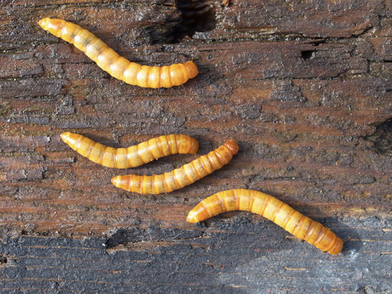10 Fascinating Facts About Mealworms
Mealworms may not be the first insect that comes to mind when thinking of nature’s wonders, but these small, wiggly creatures are full of surprises! Whether you’re a curious kid, a pet owner, or someone interested in sustainable farming, mealworms have a lot to offer. Let’s dive into some of the most interesting facts about these tiny critters and see why they’ve earned their place in both the natural world and human farming.
1. Not Actually Worms!
Despite their name, mealworms aren’t worms at all—they’re the larval stage of the darkling beetle (Tenebrio molitor). They start life as eggs, hatch into mealworm larvae, then eventually pupate and transform into adult beetles. This lifecycle makes them a key player in the insect world.
2. Super Survivors
Mealworms are incredibly adaptable and can thrive in a variety of conditions. They’ve been found in many different environments around the world, from your backyard garden to farms to even space! In fact, mealworms have been sent to the International Space Station to study how they handle life in zero gravity. Talk about tough little creatures!
3. A Nutrient-Packed Snack
Mealworms are packed with protein, healthy fats, and fiber, making them a popular choice for animal feed. But did you know they’re also becoming a go-to food source for humans? As the world looks for more sustainable protein options, mealworms are leading the way as an eco-friendly superfood! In many cultures, they are roasted, fried, or baked into snacks.
4. Masters of Recycling
One of the most amazing things about mealworms is their ability to help break down waste. They can munch through organic matter like decaying leaves, cardboard, and even Styrofoam! This makes them little recyclers in nature, turning waste into nutrients that can be used to enrich the soil. In fact, researchers are studying how mealworms might help reduce plastic waste by breaking down materials that are notoriously difficult to decompose.
5. They Love the Dark
Mealworms aren’t fans of bright lights or open spaces. They’re nocturnal creatures, which means they’re most active at night. In the wild, mealworms spend their time burrowed under leaves or soil, staying hidden from predators. In farming or pet care environments, they prefer dark, warm spaces where they can do their munching in peace.
6. Mealworms Can Go Vegan
Mealworms aren’t picky eaters! While they typically feed on grains, plant material, and decaying organic matter, they’re versatile enough to thrive on a vegan diet. This makes them easy to raise, whether you’re using them for food, feed, or composting purposes. Plus, their simple diet means they don’t require complex care.
7. Excellent Pets for Small Creatures
Do you have a pet lizard, bird, or fish? Mealworms make an excellent food source for many reptiles, amphibians, and even some mammals like hedgehogs! They’re rich in protein and are often sold in pet stores as live food, making mealtime more engaging and enriching for pets that love to hunt.
8. Cold Can Put Them to Sleep
Mealworms can be “paused” by lowering the temperature around them. When kept in a fridge at low temperatures, mealworms slow down and enter a state of dormancy. This is a handy trick for farmers and pet owners who want to keep mealworms fresh for feeding but don’t want them to grow into beetles too quickly.
9. Mealworms Help Gardeners
Gardeners love mealworms for their ability to break down organic matter and enrich the soil. When mealworms munch through decaying plant material, they help speed up the decomposition process, creating rich, nutrient-dense soil that plants thrive in. Mealworm castings (the waste they produce) are a natural fertilizer that helps plants grow stronger and healthier.
10. They May Be the Future of Farming
As the world population grows, there’s increasing interest in finding sustainable and efficient ways to produce food. Enter the mealworm! These little guys are a top contender for the future of insect farming due to their high protein content, fast growth rate, and low environmental impact. They require far less water, space, and resources compared to traditional livestock, making them an eco-friendly alternative that could play a big role in future food production.
Mealworms: More Than Just a Tiny Critter
Mealworms may be small, but they’re packed with potential! From being a sustainable food source to helping reduce waste and improve soil health, these tiny creatures are making big contributions to the planet. Whether you’re raising them for food, farming, or just fascinated by nature, mealworms have plenty of interesting traits to admire.
When you spot a squirming mealworm, keep in mind—it’s more than just an insect; it’s a tiny powerhouse of nature!


